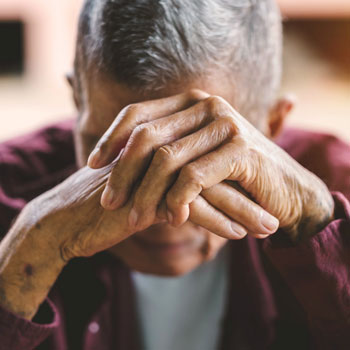Addressing suicidality in primary care
Primary care physicians are well positioned to identify patients who are at risk for suicide and who may need a mental health referral.
Forty-five percent of patients who die by suicide visit a primary care physician (PCP) within 30 days of their death, research shows, making these appointments a potentially effective time to intervene and prevent some of the nearly 50,000 suicide deaths each year. Federal guidelines have for the most part stopped short of recommending universal screening for suicide risk, but there are steps that can be taken in primary care alone or as part of other interventions to better care for these patients, experts said.
In 2023, the U.S. Preventive Services Task Force issued a grade I recommendation for universal screening for suicide risk in primary care, stating that the current evidence is insufficient to assess the balance of benefits and harms among adults, as well as a grade B recommendation supporting universal depression screening in adults.

The Task Force noted that many brief tools for depression screening are appropriate for use in primary care and that some, such as the nine-item Patient Health Questionnaire (PHQ-9), include questions about suicidal ideation. In addition, a study published in The Joint Commission Journal on Quality and Patient Safety in December 2023 found that depression screening with the PHQ-9 was the most effective way to identify patients who were at risk for attempting suicide.
However, while these tools can be helpful, it's important not to rely on them alone, since patients may not answer questions about suicide truthfully, noted Robert C. Smith, MD, MACP, professor emeritus of psychiatry and medicine at Michigan State University in East Lansing and coauthor of the book “Essentials of Psychiatry in Primary Care: Behavioral Health in the Medical Setting,” produced by ACP in partnership with McGraw-Hill.
“A screener is by no way sufficient. You need to talk to the patient,” he said.
Dr. Smith coined the mnemonic NURS to help guide physicians through conversations with patients about mental health. The “N” stands for naming the emotion. Physicians could say, “So you're feeling stressed or depressed.” Then comes “U,” for understanding: “That makes sense to me. I understand how you could feel that way.” “R” is for respect: “Thank you for telling me. I recognize you're having a tough time.” Finally, “S” is for support: “Let me know how I can help.”
He recommends first asking the patient how their life is going, then sprinkling in the NURS phrases throughout the conversation. If you ask someone whether they're having suicidal thoughts right when they walk into the office, “they're going to say ‘no’,” Dr. Smith said. Once trust has been built and the physician-patient relationship established though, those difficult topics can be introduced. And for those who might worry that mentioning suicide to their patients could plant the idea in their mind, don't, he said: “That's nonsense. That doesn't happen.”
Potential interventions
PCPs are well positioned to identify patients who are at risk and who may need a mental health referral, but it's important to have a system in place to facilitate that warm handoff.
“There are a number of risk factors in primary care that need to be addressed,” said Gary J. Kennedy, MD, director of the division of geriatric psychiatry at Montefiore Medical Center at Albert Einstein College of Medicine in New York. But “it's not fair to say, ‘Well, it's the primary care physician's responsibility,’ without adding the resources for them to be able to cope with a person's needs.”
One way to do this could involve bundling mental health and substance use interventions. A study published in Annals of Internal Medicine in October 2024 found that a population-based suicide care model implemented alongside a substance use program was associated with increased identification of at-risk patients and a 25% reduction in suicide attempt rate 90 days after primary care visits.
Researchers compared outcomes at 19 primary care practices in a large health care system in Washington State during a period of usual care—where screening for depression and substance use was done at PCPs' discretion—and after implementation of a suicide care model. The model included annual universal depression screening using the two-item PHQ (PHQ-2) and screening for alcohol use with the three-item Alcohol Use Disorders Identification Test–Consumption.
If individuals scored positive on the PHQ-2, they then completed a depression symptom assessment using the remaining seven items (PHQ-9), which was followed by the Columbia-Suicide Severity Rating Scale (C-SSRS) among those who endorsed relatively frequent thoughts about self-harm. Primary care clinicians connected patients who reported any level of intent or planning for a suicide attempt on the C-SSRS in the prior month with designated members of the care team, typically clinical social workers, for same-day safety planning.
That planning consisted of six steps intended to empower people at high risk of suicide and to support dialogue and collaboration between clinicians and patients, explained lead author Julie Angerhofer Richards, PhD, MPH, an associate scientific investigator at Kaiser Permanente Washington Health Research Institute in Seattle. The steps include recognizing suicide warning signs, employing coping strategies, utilizing social contacts to distract from suicidal thoughts, contacting family members or friends who may help resolve the crisis, contacting mental health professionals, and making the patient's environment safer.
“A lot of times, clinicians won't want to ask about suicidality if they don't feel like there are going to be resources available to help patients,” Dr. Richards said. “So that's, I think, part of the issue, and we were trying to address [that] with this project.”
Raj Sundar, MD, a family physician and district medical director at Kaiser Permanente in Washington who participated in the study, agreed that many physicians may fear bringing up topics like suicide and depression during visits because they feel like “‘If I ask about it and I find something, I have to address it [but] may only have 15 minutes,’” he said. “There's fear of not doing the right thing because of these pressures.” The intervention provided a framework to make screening a priority and part of the standard of care, he explained.
A 2022 review published by Frontiers in Medicine highlighted other ways to address suicidality in the primary care setting but stated that implementation will vary depending on a clinic's level of behavioral health integration. Of note, any primary care clinic without integrated behavioral health services should have an established relationship with local crisis lines, therapists, and other behavioral health partners, the authors wrote.
While primary care patients at acute risk of suicide should be “transferred to a higher level of care such as a behavioral health specialist [for] safety assessment and/or emergency services,” for patients at nonimminent risk, researchers recommend completing the above-outlined six-step safety planning initiative at the PCP's office, as patients experiencing suicidal thoughts do not often follow up with behavioral health referrals. In practices that do not have integrated behavioral health support, it's key to determine in advance who will create the safety plan with the patient, they said.
Maintaining contact with patients during care transitions is also crucial. During times of higher risk, researchers recommend PCPs reach out at multiple points to provide brief communications voicing concern for the patient. This can be achieved via postcards, phone calls, or text messages. PCPs should prioritize timely follow-up visits for patients recently discharged from the ED or psychiatric inpatient unit and should follow up with patients if they miss an appointment in these circumstances.
Both of these interventions, safety planning and frequent follow-up and contact, are relatively low intensity, the authors noted.
Dr. Smith stressed that if a patient is identified as having suicidal thoughts, “they need not to be out of the primary care doc's sight until a plan to have them see a mental health professional is in place.” It's also important to ask these patients if they have a specific plan to take their own life.
If a patient has suicidal ideation, even if there's no specific plan, Dr. Smith's book recommends PCPs immediately refer the patient to psychiatry or another mental health professional trained in suicidal management. If these professionals are not available and there's no plan, some believe PCPs can manage these patients if they can make a correct mental health diagnosis, maintain daily contact to ensure no plan develops, and ensure a supportive, informed family exists. However, if the patient doesn't agree and there's little to no support structure, the patient should be sent to the ED or admitted to the medical service of the hospital until a mental health professional is available, according to Dr. Smith.
This is also the recommended intervention for patients who do have a plan. In this scenario, physicians should not tell the patient's family to take them to the ED, he said: “You have the ambulance take them, because they'll talk the family out of it.”
At-risk populations
Certain populations are at higher risk of suicide than others, and it's particularly important to be aware of these groups and open up conversations with them, the experts said. These include patients with an identified mental illness or substance use disorder, patients with severe medical diseases that limit their physical mobility, patients with prior suicide attempts, and patients exposed to family violence, including physical or sexual abuse, according to the National Institute of Mental Health.
Older patients, particularly men, are also at higher risk. In 2021, the highest male suicide rates were among those ages 75 years and older, at 42.2 per 100,000, according to the NIH. For women, suicide rates were highest between the ages of 45 and 64 years, at 8.2 per 100,000.
In young people, “the ratio of suicide attempts to completed suicides is 200 to one. For older adults, it's four to one,” Dr. Kennedy said. He and colleagues published a study in Current Psychiatry Reports in 2019 that outlined warning signs for suicide in seniors that may not be present in younger adults, including loneliness and disabling physical illness.
“So, if you had one question to ask an older adult about their risk for depression, anxiety, suicide, it would be, ‘How do you rate your physical health?’ And those who say ‘poor to terrible’ are at much higher risk for depression, much higher risk for suicidality,” he said.
Older adults may also see themselves as a burden to their family, Dr. Kennedy noted. He offered some quick, nonstigmatizing questions physicians can ask to ascertain this and similar information, such as, “Who are you living with? How often do you see your family? Do you have the social support you need? Do you have a connection with friends and family that is satisfying?”
Another risk factor is access to guns. According to CDC data, in 2021, firearms were the leading mechanism of suicide for men ages 55 years and older across all age groups, and in 2022, firearm suicide rates were highest among adults ages 75 years and older, American Indian or Alaska Native persons, and non-Hispanic White persons.
But despite the established link between firearm access and suicide risk, firearm safety discussions between clinicians and adults are uncommon, research published in Annals of Internal Medicine in December 2020 shows. In a survey of over 4,000 adults who live in gun-owning households, just 7.5% said they'd ever discussed firearm safety with a clinician.
Dr. Richards is trying to change this trend by working to implement firearm suicide prevention practices. For example, step six in the safety plan employed in her study is “keeping your environment safe,” she said.
Safe storage of firearms includes keeping the gun in a secure location like a lockbox, keeping ammunition in a separate location, and storing the gun unloaded, Dr. Kennedy explained. Dr. Sundar also asks his patients about firearm access and discusses safe storage during visits, though he recognizes there can be challenges and resistance to talking about this topic in the clinical setting.
“Overwhelmingly, if I frame it as [a health issue], people are open to it. I'm not talking about gun rights. I'm not trying to bring in any political conversation to this,” he explained. “I'm saying, ‘Hey, I'm your doctor. I want you to be safe. If you have a firearm, I want it to be safely stored, because I know the risk of harming yourself is higher if it's not safely stored … and that's why I'm asking about it.’” (ACP offers resources on how to talk to patients about firearms.)
An additional resource clinicians can offer patients who have thoughts of death but no plan to hurt themselves is the 988 suicide and crisis lifeline, Dr. Kennedy added. In this case, the physician might say “If those thoughts ever get acute, if they ever get too much, call 988 ... the line will have a counselor 24 hours a day to speak with you, and that counselor can expedite services.”
Dr. Sundar acknowledged the stress and strain PCPs already feel without adding suicide intervention to their workload. But “my advice would be, it's worth it,” he said. “This is important work, and mental health is an important part of people's health. For too long, it has been made secondary… We as clinicians, as teams, as health care systems, have to design systems and processes to adequately take care of our patients and our community.”



